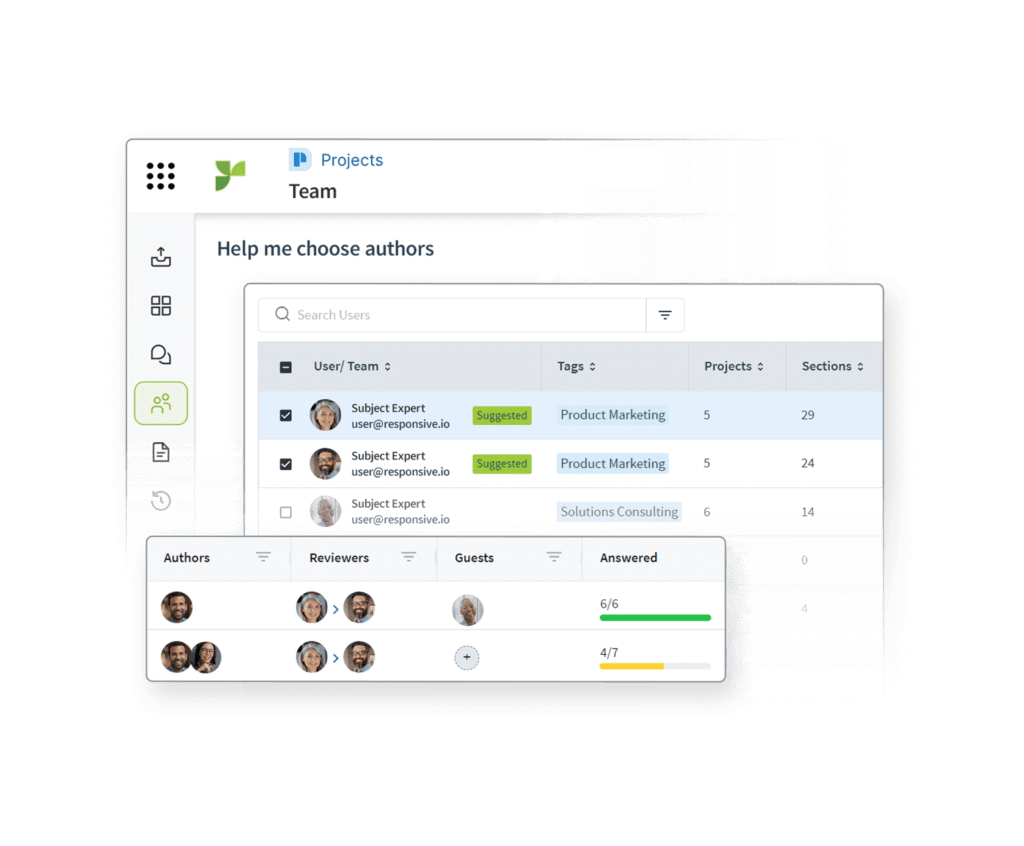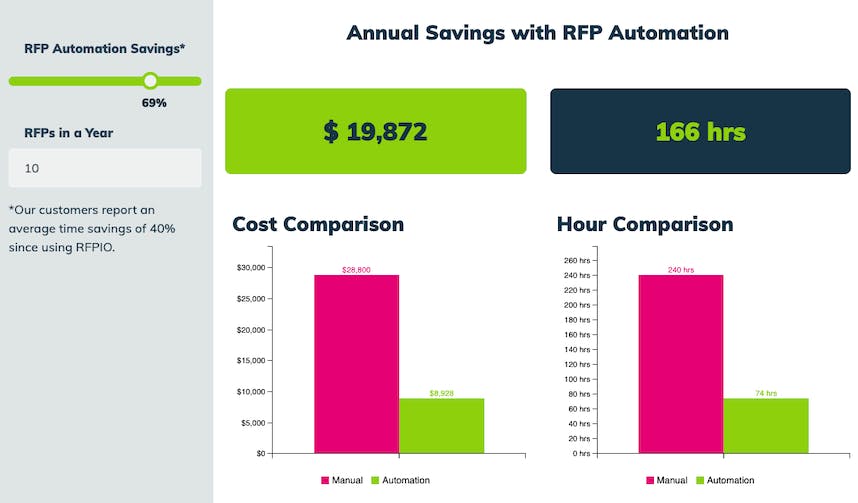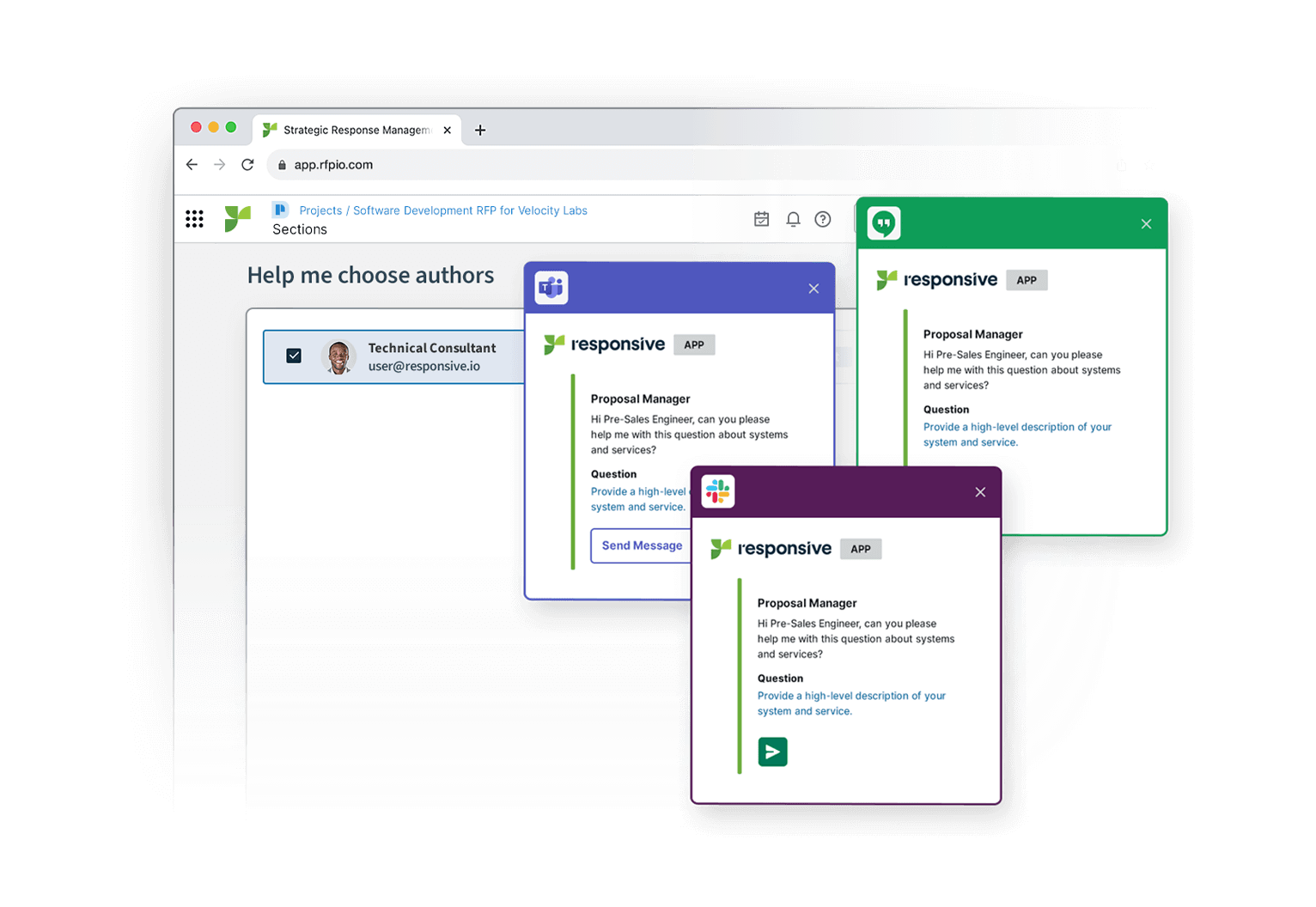Create complex RFP responses with confidence. Manage them with ease.
RFP software from Responsive not only streamlines and automates many of your existing RFP response processes, it revolutionizes how you manage projects, govern content and leverage data to pursue only the RFPs that you can win. You’ll work faster, with greater accuracy, so that you have more time to improve every response.

Intelligent response solutions for the strategic advantage.
Automation
Built-in intelligence helps you choose the most promising RFPs and RFI. Automated formatting, branding, and drafting.
Searchable knowledge libraries
Find answers to tough questions with an AI-enabled recommendation engine that scours through your company’s content in seconds.
Easy integration
Responsive integrates with CRMs, cloud storage solutions, Microsoft Office, productivity tools, sales enablement applications, and more.
Customized responses
Enhance your answers with tables, images and rich text — and export your RFPs into the source file, or your own branded template

Go from administrative hassle to strategic advantage
Let insights drive your decisions
Decide whether to respond to each RFP and RFI that comes in using built-in intelligence, keeping your team focused on the opportunities you’re most likely to win.
Automate to keep deals moving
From automated formatting and branding at intake to building up to 80 percent or more of a first draft automatically, Responsive helps you do more, faster.
Work seamlessly with integrations
Responsive integrates with CRMs, cloud storage solutions, Microsoft Office, productivity tools, sales enablement applications and more.
Put all content at your fingertips
Find answers to tough questions with an AI-enabled recommendation engine that scours through your company’s content in seconds.
Import from Word, Excel and PDF
Quickly bring in RFPs or other requests directly into the Responsive platform, where you can easily develop responses, collaborate and communicate.
Tailor responses for a competitive edge
Enhance your answers with tables, images and rich text — and export your RFPs into the source file, or your own branded template.
Smarter RFP response management software in action
Increasing RFP win rate
IBA increased win rate by 15% by improving response and bid quality
Streamlining RFP processes
Responsive saved Microsoft $4.2M by streamlining their RFX processes
Improving RFP response quality
How Genpact transformed proposal quality with an access-anywhere knowledge base
Managing RFP content
How GEODIS cuts SME review effort by 80% with strategic response management software
Accelerating RFP response times
Reducing RFX response time for a health insurance company from days to hours
Increasing RFP win rate
IBA increased win rate by 15% by improving response and bid quality
Streamlining RFP processes
Responsive saved Microsoft $4.2M by streamlining their RFX processes
Improving RFP response quality
How Genpact transformed proposal quality with an access-anywhere knowledge base
Managing RFP content
How GEODIS cuts SME review effort by 80% with strategic response management software
Accelerating RFP response times
Reducing RFX response time for a health insurance company from days to hours
Collaborate + integrate across platforms
Users from across your company can access Responsive through more than two dozen applications you already use, including:
- CRMs – Access the Responsive content library through your company’s chosen CRM, including Salesforce, Pipedrive, Dynamics 365, PipelineDeals, and HubSpot.
- Communication apps – Responsive enables company-wide collaboration through your existing communication apps, including Slack, Google Hangouts, Jira, and Microsoft Teams.
- Cloud storage apps – Seamlessly integrate Responsive with Sharepoint, Box, Dropbox, Google Drive, and OneDrive.
- SSO authentication apps – Work within your company’s security protocols through SSO authentication integrations with Microsoft ADFS, Microsoft Azure, OneLogin, and Okta.
- Browser extensions – Access the content library through Responsive® LookUp and Chrome.
- Vendor assessment apps – Securely import directly from third-party platforms using Whistic.
- Productivity apps – Work faster using Responsive with Microsoft Suites and Google Sheets.
- Sales enablement apps – Revenue-generating employees can access Responsive through Seismic or Highspot.

AI assistance: smarter analysis, faster responses
Leverage Responsive to:
- Auto-identify response content – The advanced artificial intelligence in the Responsive platform automatically identifies response content.
- Get automated answers – The AI-powered recommendation engine pulls from the content library to recommend answers based on previous similar questions.
- Assign questions to pertinent subject matter experts – With Responsive, there’s no more trying to figure out the best people to help with your RFP. AI technology identifies relevant and available SMEs.
- Analyze win-loss opportunities – Not all RFPs are worth a response. Have you won similar bids in the past? Is this one worth it? Responsive learns from previous wins and losses to help you decide whether to pursue the next one.

Content management, unified and simplified
The Content Library in the Responsive Platform:
- Stores marketing approved content in one place – Your company’s single source of truth.
- Lets you stitch together high-quality content – Browse previous responses to create customized answers.
- Makes creating content easy– Once you answer a question, you can store the Q&A pair for future needs. As your company accumulates knowledge or documents, it’s simple to upload it into your content library.
- Streamlines content formatting – Organize and format content however you like.
- Automates responses – With just a few clicks, Responsive customers answer up to 80 percent of the questions on an RFP, regardless of the format.
- Encourages regular content audits – Keep your content library fresh and up to date with regular audits. Responsive will remind you when it’s time to review specific content.

#1 RFP response software on G2 for 4 years and counting
Don’t take our word for it. Based on hundreds of user reviews, G2 has recognized Responsive as the leader in 14 software categories, including RFP Software, Proposal, Vendor Security and Privacy Assessment, and Document Generation.

